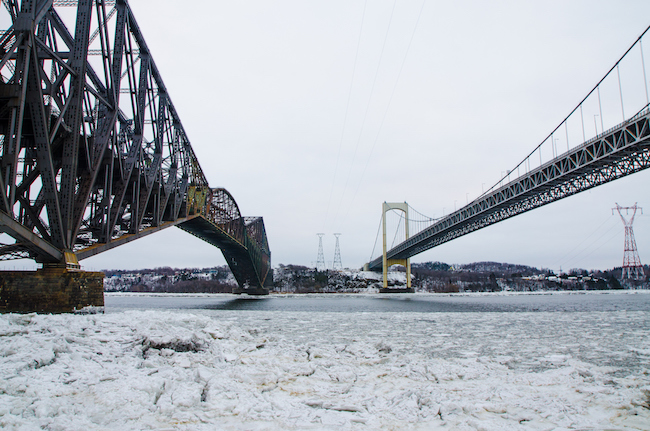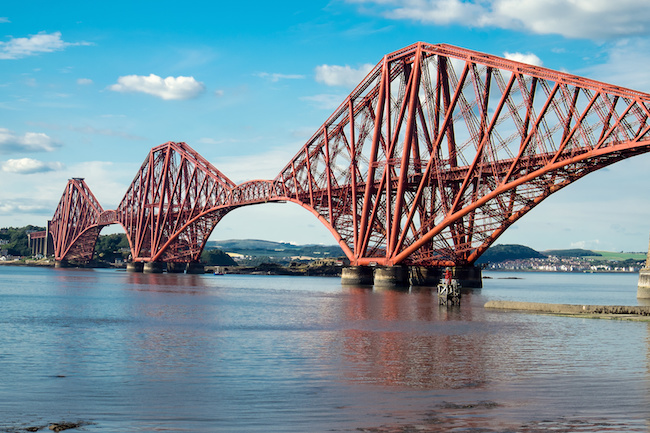

The Quebec bridge on the left, with the far newer Pierre Laporte Bridge, which was completed in 1970 on the right. PHOTO: Getty Images
It’s old, plenty rusty and somewhat less refined than the far newer suspension bridge that stands beside it. But even after a century of wear and tear, the Quebec Bridge is something to behold. It’s worth hanging onto and it’s worth the cost of a new paint job.
Completed in 1917 after weathering two separate tragedies, the kilometre-long bridge over the St. Lawrence River in Quebec City is a feat of engineering. To this day, it’s the longest clear span cantilever bridge in the world, measuring 549-metres (1,801-feet) between its two main pillars.
Cantilever bridges are massive, heavy structures that are almost brutalist in appearance. Steel arms, or cantilevers, extend toward the middle of the bridge to support a central span, while anchor arms reach outward from the main piers to counterbalance the weight.
Construction began on the Quebec Bridge along the banks of the St. Lawrence in fall 1900 and continued relatively smoothly for nearly seven years.
Tragedy struck one afternoon in August 1907. Around 5:30 p.m., residents in downtown Quebec City, a dozen kilometres away, heard a thunderous crash. In a matter of 15 seconds, thousands of tons of steel collapsed into the river. Of the 86 workers on the bridge at the time, 75 were killed, according to the official inquiry into the incident. One survivor, identified simply as Huot, escaped by sprinting off the bridge as it collapsed beneath him.
Design flaws and errors in judgement by on-site engineers, who observed issues in the weeks leading up to the disaster, were blamed for the collapse.
It took years to clear the river of debris and prepare for a second attempt. A new team of engineers designed a stronger and heavier bridge, utilizing nickel alloy steel for one of the first times on a large scale. Crews began work on the second bridge in 1913.
Construction progressed far faster than on the original and it was approaching completion in 1916 when again, disaster struck. On Sept. 11, a crowd gathered beside the river to witness the central span of the bridge, which had been assembled off-site, get raised into place. As crews jacked up the huge steel piece, a component of the lifting apparatus failed, sending the 5,000-ton central span plummeting into the river. Even today, it remains at the bottom of the St. Lawrence.
13 workers died in the second accident and more than a dozen others were injured.
The builders were undeterred and began fabricating a new central span off-site. One year later, workers hoisted the new steel segment into place. A train carrying several hundred passengers crossed the completed bridge for the first time in October 1917.
Today, CN Rail owns the iconic bridge. The railway ensures the span remains structurally sound, but has been unwilling to set aside any funds for projects it views as cosmetic.

The famed Forth Bridge in Scotland with its iconic red paint coat. It recently underwent significant upgrades
After years of quibbling over restoration work, the federal government has expressed an interest in buying back the piece of Canadiana. This August it appointed a negotiator to push forward with either a restoration deal or purchase. Local politicians and residents in Quebec City have also been long-time advocates of restoring the rusting bridge.
It wouldn’t be the first to get a new coat of paint. Another famed cantilever bridge – the Forth Bridge in Scotland – recently underwent a striking facelift. A UNESCO World Heritage Site, the bridge is a destination in its own right. There’s no reason the Quebec Bridge shouldn’t be.
Estimated at several hundred million dollars, restoring the Quebec Bridge is admittedly a costly endeavour. Still, giving an irreplaceable piece of Canadian history a new lease on life is worth the cost of a paint job.
This column first appeared in the October 2019 edition of On-Site. Click here to read through the entire issue.




